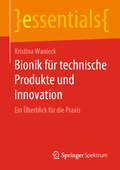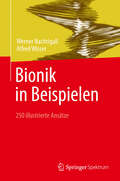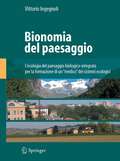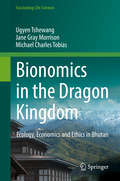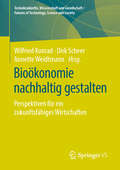- Table View
- List View
Bionik für technische Produkte und Innovation: Ein Überblick für die Praxis (essentials)
by Kristina WanieckDie Bionik überträgt Wissen über biologische Vorbilder in technische Anwendungen und kann damit für die Entwicklung technischer Produkte und Innovationen genutzt werden. Es handelt sich dabei um einen der spannendsten Ansätze für zukünftige technische und gesellschaftliche Innovation, da das meiste Wissen aus der Biologie bisher noch ungenutzt ist. Kristina Wanieck fasst in diesem essential die wichtigsten Grundlagen der Bionik für ihre Anwendung in der Praxis zusammen. Darüber hinaus beschreibt die Autorin eine themen- und problemoffene Vorgehensweise – also unabhängig von einer konkreten Fragestellung. Diese Grundlagen sollen es ermöglichen, die Bionik für die verschiedensten Fragestellungen und Projekte zu nutzen.
Bionik in Beispielen: 250 illustrierte Ansätze
by Werner Nachtigall Alfred WisserBionik betreiben bedeutet, von der Natur für die Technik lernen. Die Wissenschaft „Bionik“ lässt sich in mehrere Teilgebiete untergliedern, von Materialien und Strukturen über Verfahren und Abläufe bis zu Evolution und Optimierung. Auf all diesen Gebieten gibt es bereits vielerlei Ansätze. In der Öffentlichkeit - und seltsamerweise auch in den naturwissenschaftlichen Fachdisziplinen - sind aber nur wenige wirklich bekannt. Dazu zählen der Lotus-Effekt, umgesetzt für die Verschmutzungsverminderung von Fassaden, und der Haischuppen-Effekt, umgesetzt für die Widerstandsreduzierung von Flugzeugen. Dabei gibt es aber heute schon hunderte von hochinteressanten Ansätzen, die eine Umsetzung von Naturprinzipien in die Technik zum Inhalt haben. Aus der Fülle dieser Ansätze sind für das vorliegende Buch 250 ausgewählt nach „Vorgeschichte“, „Frühgeschichte“, „Klassik“ und „Neuzeit“. Die meisten Beispiele sind neuerer Art. Jedes Beispiel umfasst in gleichartiger Gliederung eine Druckseite. Die Beispiele aus dem Bereich „Neuzeit“ sind in Blocks gegliedert, die den Unterdisziplinen der Bionik entsprechen.
Bionische Unternehmensführung: Mitarbeitermotivation als Schlüssel zu Innovation, Agilität und Kollaboration
by Rüdiger FoxDieses Buch zeigt, was die Prinzipien der Evolution mit Ameisen und dem Staat Bhutan gemeinsam haben. Mit dem „Gross Corporate Happiness“ Ansatz stellt es ein wissenschaftlich fundiertes und in der Praxis erprobtes Führungsmodell vor und erhebt den Mitarbeiter vom Kostenfaktor zum wirtschaftlich wichtigsten Treiber für nachhaltigen Unternehmenserfolg in der Wissensgesellschaft. Das Werk liefert Antworten auf die brennendsten Fragen der Unternehmensführung im Kontext von Globalisierung und Digitalisierung: Wie motiviere ich meine Mitarbeiter richtig? Wie steigere ich die Innovationsleistung meines Unternehmens? Wie schaffe ich eine Kultur von Kooperation, Agilität und Resilienz in Zeiten beständigen Wandels? Dr. Rüdiger Fox erläutert wie intrinsische Motivation im Wirtschaftskontext zum Business Case wird und schlüsselt dafür die organisationsinternen Rahmenbedingungen auf, die neben der Zufriedenheit und dem „Flow“, die Innovations- und Kooperationsfähigkeit der Mitarbeiter steigern. Aus seiner praktischen Führungserfahrung schöpfend, zeigt der Autor, wie Organisationen in komplexen und dynamischen Märkten damit deutlich effizienter werden.
BioNMR in Drug Research (Methods and Principles in Medicinal Chemistry #16)
by Raimund Mannhold Hugo Kubinyi Gerd FolkersThe vast progress made in the investigation of biomolecules using NMR has only recently been rewarded with the Nobel Prize for Kurt Wuthrich. Edited by a former coworker of Wuthrich, this book presents the theoretical background on NMR of biomolecules, plus the use of NMR techniques in determining the structures of proteins and nucleic acids. BioNMR spectroscopy offers a universal tool for examining the binding of an active substance to its target protein. Its use thereby benefits the rational development of drugs. This interaction can now be investigated in a hitherto unparalleled precision and displayed in 3D - an important prerequisite for the targeted development of new active substances. The latest methods for characterizing substance-receptor complexes are demonstrated backed by many case studies from pharmaceutical research. Thus it comes as no surprise that a large number of the authors are working for leading pharmaceutical companies. With its successful mixture of basic information and application strategies, coupled with many real-life examples, this is an invaluable guide for both NMR spectroscopists and pharmaceutical researchers.
Bionomia del paesaggio: L'ecologia del paesaggio biologico-integrata per la formazione di un medico dei sistemi ecologici
by Vittorio IngegnoliL’ecologia del paesaggio biologico-integrata, o meglio “Bionomia del Paesaggio”, si propone come un atto di rifondazione della disciplina iniziato dall’Autore una dozzina di anni fa, con l’appoggio di Richard Forman, basato sul riconoscimento del paesaggio come specifico livello dell’organizzazione della vita sulla Terra. A scala territoriale, in un determinato ambito geografico, il “paesaggio” si definisce come “integrazione di un insieme di comunità vegetali, animali ed umane e del loro sistema di ecosistemi naturali, seminaturali e antropico-culturali in una certa configurazione spaziale”, cioè come sistema iper-complesso che costituisce una entità vivente: non un insieme incoerente, quindi, di aspetti e di tematiche separate (acqua, aria, suolo, specie, inquinamenti) tra cui si possano trovare delle interrelazioni! Ciò porta, inevitabilmente, notevoli cambiamenti nelle modalità di valutare e gestire l’ambiente. Possiamo, infatti, riconoscere delle strutture e delle funzioni proprie di ogni paesaggio, ossia dei comportamenti peculiari che vanno oltre le classiche relazioni fra le componenti perché dovuti a leggi sistemiche. Si può così parlare di uno “stato di salute” e di una serie di sindromi (o patologie) del paesaggio. Questo fatto è assai rilevante, perché si è dimostrato che le alterazioni patologiche di un paesaggio, o di una sua parte, possono influire sulla salute umana, anche in assenza di inquinamenti! Prestiamo attenzione al fatto che si può intervenire sul territorio con le migliori intenzioni causando invece un danno! Ne consegue la necessità di studiare le “unità di paesaggio” con un metodo “clinico-diagnostico” e di considerare gli ecologi come “medici” dei sistemi ecologici, cioè “ecoiatri”.
Bionomics in the Dragon Kingdom: Ecology, Economics and Ethics in Bhutan (Fascinating Life Sciences)
by Ugyen Tshewang Jane Gray Morrison Michael Charles TobiasThis compact and elegant work (equally fitting for both academic as well as the trade audiences) provides a readily accessible and highly readable overview of Bhutan’s unique opportunities and challenges; all her prominent environmental legislation, regulatory statutes, ecological customs and practices, both in historic and contemporary terms. At the same time, Bionomics places the ecological context, including a section on animal rights in Bhutan, within the nation’s Buddhist spiritual and ethical setting. Historic contextualization accents the book’s rich accounting of every national park and scientific reserve, as well as providing up-to-the-minute climate-change related hurdles for the country.Merging the interdisciplinary sciences, engineering and humanities data in a compelling up-to-date portrait of the country, the authors have presented this dramatic compendium against the backdrop of an urgent, global ecological time-frame. It thus becomes clear that the articulated stakes for Bhutan, like her neighboring Himalayan and Indian sub-continental countries (China, India, Bangladesh and Myanmar) are immense, as the Anthropocene epoch unfolds, affecting every living being across the planet. Because Bhutan’s two most rewarding revenue streams derive from the sale of hydro-electric power and from tourism, the complexities of modern pressures facing a nation that prides herself on maintaining traditional customs in what has been a uniquely isolated nation are acute.
Bion's Dream: A Reading of the Autobiographies
by Meg Harris Williams'This book offers a definitive reading of Bion's remarkable autobiographical writings from a perspective embedded in the poetry of the ages, that of the Romantics in particular. It is at once learned and, utterly freshly, able to explore the inside story of Bion's life and mind. The volume is a distillation and elaboration of the work of many years. Whilst ostensibly an extended commentary on the autobiographical works themselves, it is also, in its own right, a tour de force, engaging, as it does, with the heart of the matter: with the development of a psychoanalyst, of a life, a self, a mind, thoroughly inward with the "dark and sombre world of thought".'- Margot Waddell, psychoanalyst and consultant child psychotherapist, Tavistock Clinic
Bion's Dream: A Reading of the Autobiographies
by Meg Harris Williams'This book offers a definitive reading of Bion's remarkable autobiographical writings from a perspective embedded in the poetry of the ages, that of the Romantics in particular. It is at once learned and, utterly freshly, able to explore the inside story of Bion's life and mind. The volume is a distillation and elaboration of the work of many years. Whilst ostensibly an extended commentary on the autobiographical works themselves, it is also, in its own right, a tour de force, engaging, as it does, with the heart of the matter: with the development of a psychoanalyst, of a life, a self, a mind, thoroughly inward with the "dark and sombre world of thought".'- Margot Waddell, psychoanalyst and consultant child psychotherapist, Tavistock Clinic
Bion's Legacy: Bibliography of Primary and Secondary Sources of the Life, Work and Ideas of Wilfred Ruprecht Bion
by Harry KarnacThis book forms a comprehensive bibliography of the works of W. R. Bion, and the other works that made some bearing of his life and thought. It discusses Bion's contribution to various disciplines beyond the psychoanalytic and psychotherapeutic.
Bion's Legacy: Bibliography of Primary and Secondary Sources of the Life, Work and Ideas of Wilfred Ruprecht Bion
by Harry KarnacThis book forms a comprehensive bibliography of the works of W. R. Bion, and the other works that made some bearing of his life and thought. It discusses Bion's contribution to various disciplines beyond the psychoanalytic and psychotherapeutic.
Bion’s Legacy in São Paulo: Theoretical Applications from the São Paulo Psychoanalytic Society (SBPSP) (The Routledge Wilfred R. Bion Studies Book Series)
by Evelise de Souza MarraThis collection illuminates the legacy of Wilfred R. Bion in Brazil, illustrating Bion’s continued influence on the work of the São Paulo Psychoanalytic Society (SBPSP), how Bionian ideas are applied in contemporary psychoanalysis, and how current practice has evolved over time. Evelise de Souza Marra and Cecil José Rezze bring together theoretical and clinical approaches to provide a thorough perspective on Bionian work in Brazil. The book includes chapters by senior analysts, well-respected teachers and analytic clinicians in contemporary Brazilian psychoanalysis, each of which explores a topic central to Bion’s formulations. With discussion of key themes including turbulence, emotional experience, transference, caesura and mental pain, this book demonstrates how Wilfred R. Bion’s thought has been developed, transformed and applied in Brazil since his visits there in the 1970s. Bion’s Legacy in São Paulo will be of great interest to psychoanalysts in practice and in training, particularly those looking to understand Bion’s influence in more depth, and for anyone interested in the practice of psychoanalysis in Latin America.
Bion’s Legacy in São Paulo: Theoretical Applications from the São Paulo Psychoanalytic Society (SBPSP) (The Routledge Wilfred R. Bion Studies Book Series)
by Evelise De Souza Marra Cecil José RezzeThis collection illuminates the legacy of Wilfred R. Bion in Brazil, illustrating Bion’s continued influence on the work of the São Paulo Psychoanalytic Society (SBPSP), how Bionian ideas are applied in contemporary psychoanalysis, and how current practice has evolved over time. Evelise de Souza Marra and Cecil José Rezze bring together theoretical and clinical approaches to provide a thorough perspective on Bionian work in Brazil. The book includes chapters by senior analysts, well-respected teachers and analytic clinicians in contemporary Brazilian psychoanalysis, each of which explores a topic central to Bion’s formulations. With discussion of key themes including turbulence, emotional experience, transference, caesura and mental pain, this book demonstrates how Wilfred R. Bion’s thought has been developed, transformed and applied in Brazil since his visits there in the 1970s. Bion’s Legacy in São Paulo will be of great interest to psychoanalysts in practice and in training, particularly those looking to understand Bion’s influence in more depth, and for anyone interested in the practice of psychoanalysis in Latin America.
Bion's Legacy to Groups
by David Armstrong Franco Borgogno Parthenope Bion Talamo Silvio A. Merciai'It is characteristic of some forms of scientific genius to alter not just what we see in the world, but how we see it - not just the view, but the lens. One thinks of Freud's discovery of the transference, or of Melanie Klein's attention to the play of children. Wilfred Bion's study of groups and group processes also has this quality. More than the content of what he saw and captured in the concepts of two modes of mental functioning in groups and in the differentiation of the basic assumptions, it was the way he saw or, more broadly, the way he sensed the emotional life of the individual in the group, and in the first instance his own, that opened up a quite new territory for exploration. Those of us whose practice takes place primarily in the institutional or social domain can find in his more psychoanalytic work seeds of new thought extending beyond the consulting room.Going "beyond the confines" might perhaps more generally stand as a metaphor for Bion's enterprise.
Bion's Legacy to Groups
by Franco Borgogno Parthenope Bion Talamo Silvio A. Merciai'It is characteristic of some forms of scientific genius to alter not just what we see in the world, but how we see it - not just the view, but the lens. One thinks of Freud's discovery of the transference, or of Melanie Klein's attention to the play of children. Wilfred Bion's study of groups and group processes also has this quality. More than the content of what he saw and captured in the concepts of two modes of mental functioning in groups and in the differentiation of the basic assumptions, it was the way he saw or, more broadly, the way he sensed the emotional life of the individual in the group, and in the first instance his own, that opened up a quite new territory for exploration. Those of us whose practice takes place primarily in the institutional or social domain can find in his more psychoanalytic work seeds of new thought extending beyond the consulting room.Going "beyond the confines" might perhaps more generally stand as a metaphor for Bion's enterprise.
Bion's Sources: The shaping of his paradigms
by Nuno Torres R. D. HinshelwoodThere are an increasing number of publications concerned with the work of Wilfred Bion (1897-1979). Many have sought new ideas from his writing however, little attention has been paid to the intellectual context in which Bion wrote. Bion’s Sources traces where Bion’s new ideas came from, what job he required of them, how successfully he used his context and how that has fertilised psychoanalysis. Expert contributors provide chapters on areas of the intellectual context separate from or adjacent to clinical psychoanalysis in Britain which have clearly influenced the texts Bion left (those published in his life time, or subsequently). Chapters explore the influences deriving from Wilfred Trotter, Henri Bergson and process philosophy, Kurt Lewin and group dynamics, Immanuel Kant, R. B. Braithwaite and the philosophy of science, the mathematics of notation and transformation, as well as the work of psychoanalysts who have applied their theories to social science, psychosomatics, and literature and the humanities. By contextualising Bion in the wider culture of ideas, and removing him from the exclusive world of Psychoanalysis, Bion’s Sources aims to moderate his ‘genius’ by showing how it was shaped by very wide influences. This book will be of interest to psychoanalysts, clinicians and those interested in the history of psychoanalytic ideas.
Bion's Sources: The shaping of his paradigms
by Nuno Torres R. D. HinshelwoodThere are an increasing number of publications concerned with the work of Wilfred Bion (1897-1979). Many have sought new ideas from his writing however, little attention has been paid to the intellectual context in which Bion wrote. Bion’s Sources traces where Bion’s new ideas came from, what job he required of them, how successfully he used his context and how that has fertilised psychoanalysis. Expert contributors provide chapters on areas of the intellectual context separate from or adjacent to clinical psychoanalysis in Britain which have clearly influenced the texts Bion left (those published in his life time, or subsequently). Chapters explore the influences deriving from Wilfred Trotter, Henri Bergson and process philosophy, Kurt Lewin and group dynamics, Immanuel Kant, R. B. Braithwaite and the philosophy of science, the mathematics of notation and transformation, as well as the work of psychoanalysts who have applied their theories to social science, psychosomatics, and literature and the humanities. By contextualising Bion in the wider culture of ideas, and removing him from the exclusive world of Psychoanalysis, Bion’s Sources aims to moderate his ‘genius’ by showing how it was shaped by very wide influences. This book will be of interest to psychoanalysts, clinicians and those interested in the history of psychoanalytic ideas.
Bion’s Theory of Dreams: A Visionary Model of the Mind
by João Sousa MonteiroThrough a richly detailed close reading of Wilfred R. Bion’s work on dreaming, as scattered across multifarious and largely unworked texts, this book argues that Bion’s thinking can form a unified theory of dreams which extends and has further implications as a visionary model of the mind. The central quality of Bion's visionary model of the mind is the belief that all that is interesting in the human mind pulsates with an unreadably complex dynamic beyond the unknown, the unknowable and the unthinkable. However, rather than interpreting this negatively, the author understands the inevitable unknowability of the human mind as a call to perplexity and wonder which actively encourages the intuition of fundamental insights into who and what determines our internal lives. A major implication of this belief is that psychoanalysis is itself essentially about the unknown, and Monteiro generates informed observations about how this may influence psychoanalytic work. Providing renewed insight into psychoanalytical understandings of dreams, this book is essential reading for any psychoanalyst wishing to broaden their knowledge of the importance of Wilfred R. Bion’s dream work.
Bion’s Theory of Dreams: A Visionary Model of the Mind
by João Sousa MonteiroThrough a richly detailed close reading of Wilfred R. Bion’s work on dreaming, as scattered across multifarious and largely unworked texts, this book argues that Bion’s thinking can form a unified theory of dreams which extends and has further implications as a visionary model of the mind. The central quality of Bion's visionary model of the mind is the belief that all that is interesting in the human mind pulsates with an unreadably complex dynamic beyond the unknown, the unknowable and the unthinkable. However, rather than interpreting this negatively, the author understands the inevitable unknowability of the human mind as a call to perplexity and wonder which actively encourages the intuition of fundamental insights into who and what determines our internal lives. A major implication of this belief is that psychoanalysis is itself essentially about the unknown, and Monteiro generates informed observations about how this may influence psychoanalytic work. Providing renewed insight into psychoanalytical understandings of dreams, this book is essential reading for any psychoanalyst wishing to broaden their knowledge of the importance of Wilfred R. Bion’s dream work.
Bioökonomie: Impulse für ein zirkuläres Wirtschaften (FOM-Edition)
by Barnim G. Jeschke Thomas HeupelIn der Definition der Bundesregierung umfasst die Bioökonomie die „Erzeugung, Erschließung und Nutzung biologischer Ressourcen, Prozesse und Systeme, um Produkte, Verfahren und Dienstleistungen in allen wirtschaftlichen Sektoren im Rahmen eines zukunftsfähigen Wirtschaftssystems bereitzustellen“. Viele Publikationen adressieren stark die technologischen Facetten der Bioökonomie. In dem vorliegenden Sammelband werden hingegen Anwendungsaspekte, Potenziale und Hemmnisse aus wissenschaftlicher – aber eben auch aus betrieblicher – Sicht reflektiert, um konkrete Erkenntnisse für Geschäftsmodelle abzuleiten, die regenerative Rohstoffe in ihre Wertschöpfung einbeziehen. Die branchenbezogenen Erkenntnisse münden in einen Leitfaden, der Aufschluss über den bioökonomischen Reifegrad des jeweiligen Unternehmens gibt.
Bioökonomie für Einsteiger
by Joachim Pietzsch Stephan Meyer Wolfgang Zettlmeier Ulrich SchurrDieses Buch bietet eine aktuelle und gut lesbare Einführung in die Bioökonomie. Es vermittelt damit grundlegende Kenntnisse zum Verständnis eines Transformationsprozesses, der das 21. Jahrhundert prägen wird und die Integration vieler Disziplinen und Branchen verlangt, die bisher wenig miteinander zu tun hatten. Die Rede ist von dem allmählichen und notwendigen Übergang aus dem Zeitalter fossiler Brennstoffe, das vor rund 200 Jahren begann, in eine weltweite Wirtschaftsform, die auf nachwachsenden Rohstoffen (und erneuerbaren Energien) basiert. Dieses Buch begreift die Verwirklichung von Bioökonomie(n) dabei als eine dreifache Herausforderung – eine naturwissenschaftliche, eine ökonomische und eine ökologische. Woher stammt die Biomasse, die wir vorrangig für die Ernährung der wachsenden Weltbevölkerung wie auch für eine zukünftige energetische und stoffliche Nutzung brauchen? Wie wird sie in Bioraffinerien verarbeitet und welche Rolle kommt der Biotechnologie zu? Welche Gesichtspunkte der Innovationsökonomie gilt es zu bedenken, welche betriebswirtschaftlichen Aspekte der Wertschöpfung, Wettbewerbsfähigkeit und Kundenakzeptanz sind von Bedeutung? Welche Bedingungen muss die Bioökonomie erfüllen, um eine nachhaltige Entwicklung der Erde zu ermöglichen? Darf sie überhaupt auf Wachstumsziele setzen oder sollte sie sich nicht besser am Ideal der Suffizienz orientieren? Indem das Buch diese Fragen aus den nicht widerspruchsfreien Perspektiven ausgewiesener Experten behandelt, gibt es einen interdisziplinären Überblick über ein dynamisches Feld von Forschung und Praxis, der mehr Fragen aufwirft als beantwortet und dennoch eine Lücke schließt. Denn bisher gibt es keine verständliche und fachübergreifende Darstellung der Bioökonomie. Das macht die Lektüre dieses Buches zu einem Gewinn nicht nur für Einsteiger, sondern auch für Fachleute, die über die Grenzen ihres eigenen Fachgebietes hinausschauen wollen.
Bioökonomie im Selbststudium: Grundlagen und Ausgangspunkte (Zertifikatskurs Bioökonomie)
by Joachim PietzschDieses Studienheft ist ein Teil des Springer Zertikfikatskurses Bioökonomie und wird als Material zum Selbstlernen eingesetzt.Historische Einordnung | Entstehung des Begriffs Bioökonomie | Verschiedene politische Strategien der Bioökonomie| Bioökonomie und Nachhaltigkeit | Kaskadennutzung und Kreislaufwirtschaft| Profilierte Bioökonomie-Regionen in Deutschland | Gesetzliche Rahmenbedingungen | Die sieben Herausforderungen der Bioökonomie | Vorstellung beispielhafter Produkte | Fallstudien
Bioökonomie im Selbststudium: Nachhaltigkeit und ökologische Bewertung (Zertifikatskurs Bioökonomie)
by Rüdiger Schaldach Christine Rösch Jan GöpelDer menschengemachte Klimawandel, knapper werdende natürliche Ressourcen und eine stetig wachsende Weltbevölkerung sind globale Herausforderungen, die ein Umdenken und Umsteuern der Wirtschaft erfordern, um Ernährung und Wohlstand der Menschen auch in Zukunft zu sichern. Die Bioökonomie bietet dafür vielfältige moderne Lösungsansätze, die nicht auf fossilen Ressourcen, sondern auf der effizienten Nutzung von biologischen Ressourcen, wie Pflanzen, Tieren und Mikroorganismen basieren. Dennoch sind nicht alle Technologien und Produkte der Bioökonomie per se nachhaltig. Was genau unter einer nachhaltigen Bioökonomie verstanden wird, mit welchen Indikatoren und Methoden Nachhaltigkeit gemessen werden kann und wie die Zertifizierung von nachhaltigen Produkten erfolgt, erfahren Sie in diesem Band. Wir erläutern Ihnen, wie sich nachhaltiges Denken und Handeln in Unternehmen integrieren und dessen Umsetzung quantifizieren und überwachen lässt. Wir führen Sie in die Methodik zur ökologischen Bewertung von Wertschöpfungsketten ein und zeigen Ihnen, wie Lebenszyklusanalysen erstellt und Ressourcen-Fußabdrücke berechnet werden. Zudem lernen Sie Szenarien als Werkzeug kennen, um Pfade der zukünftigen Bioökonomie zu analysieren. Am Ende vertiefen wir mit Ihnen das gewonnene Verständnis und die gelernten Methoden anhand aktueller und politischer relevanter Fallstudien der Bioökonomie.
Bioökonomie im Selbststudium: Unternehmensstrategie und Wirtschaftlichkeit (Zertifikatskurs Bioökonomie)
by Manfred KircherDieser Band geht auf die Wettbewerbsfähigkeit in den Märkten der Ernährung, bio-basierter Materialien und von Bio-Energie ein. Besonders angesprochen werden die Wettbewerbsfaktoren der Qualität, der Nachhaltigkeit und der Kosten bio-basierter Produkte. Auch auf die politischen Rahmenbedingungen wird eingegangen. Es folgt eine Analyse der Zielkonflikte, die die Bioökonomie mit sich bringt, wie Unternehmen zu deren Lösung beitragen können, welche Instrumente es für die Dokumentation der Nachhaltigkeit bio-basierter Produkte gibt und wie damit gesellschaftliche Akzeptanz und ein Wettbewerbsvorteil erreicht werden können. Abschließend lernen die Teilnehmer Organisationen und Netzwerke kennen, die die Formulierung von Unternehmensstrategien und die Erreichung von Wettbewerbsvorteilen unterstützen.
Bioökonomie im Selbststudium: Wertschöpfungsketten und Innovationspotenzial (Zertifikatskurs Bioökonomie)
by Manfred KircherDieser Band diskutiert die an den Wertschöpfungsketten der Bioökonomie vom Rohstoff bis zum Endprodukt beteiligten Wirtschaftssektoren. Angesprochen werden die Biomasse produzierenden Branchen und das vielfältige produzierende Gewerbe einschließlich der Abfallwirtschaft. Darauf folgt eine Analyse, wie weit die Bioökonomie in den verschiedenen Sektoren schon etabliert ist und in welchen Branchen sie zukünftiges Potential hat. Bis 2050 soll der Rohstoffwandel von fossilen zu nachhaltigen Rohstoffen entsprechend dem Pariser Klimaabkommen weitgehend abgeschlossen sein. Heute noch von fossilen Rohstoffen ausgehende Unternehmen werden sich deshalb zunehmend auf die kommende Bioökonomie einstellen müssen. Die Teilnehmer lernen, die hierin liegenden Herausforderungen, aber auch das große Potential für Innovation und die Verbesserung der Wettbewerbsfähigkeit, das in der Verknüpfung der beteiligten Wertschöpfungsketten liegt, zu erkennen.
Bioökonomie nachhaltig gestalten: Perspektiven für ein zukunftsfähiges Wirtschaften (Technikzukünfte, Wissenschaft und Gesellschaft / Futures of Technology, Science and Society)
by Wilfried Konrad Dirk Scheer Annette WeidtmannIn diesem Sammelband werden die Herausforderungen und Potenziale einer zukünftig nachhaltig zu gestaltenden Bioökonomie interdisziplinär beleuchtet. Hierbei wird die Bioökonomie als sozio-technisches System aufgefasst, in dem die technische Ausgestaltung aufs Engste mit sozialen, ökonomischen und politischen Elementen verknüpft ist. Aus unterschiedlichen Perspektiven wird die Transformation des herkömmlichen Wirtschaftens in Richtung einer bioökonomischen Wirtschaftsweise thematisiert. Aspekte von Umbau bzw. Transformation und Zukunftsgestaltung stehen dabei im Mittelpunkt.
